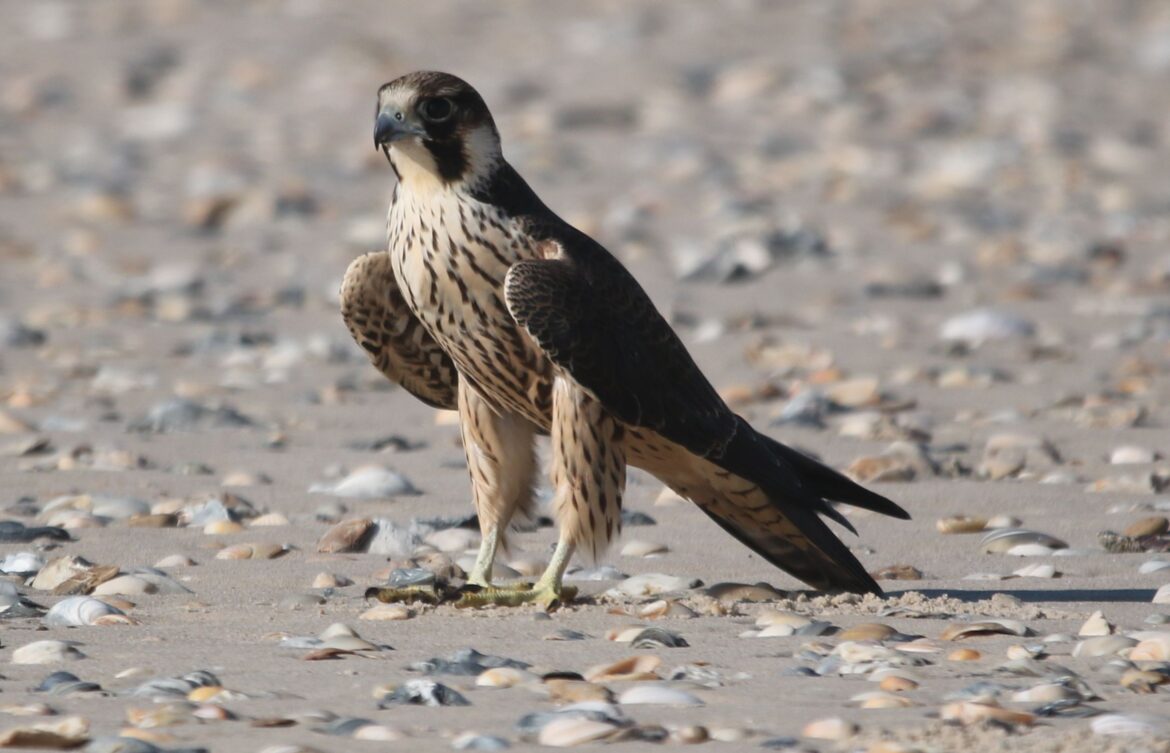by Taylor Bennett
Gulf Coast Bird Observatory’s avian research team is monitoring for non-breeding shorebirds along the Upper Texas Coast from now until the end of March. Our main focus is those species that are classified as endangered, threatened, or of high concern due to habitat loss and climate change. There are six target species we monitor: Piping Plover, Red Knot, Snowy Plover, Wilson’s Plover, American Oystercatcher, and Black Skimmer. The sites we monitor are Matagorda Beach, Bryan Beach, Quintana Beach, Surfside Beach, and Follet’s Island. During monitoring, we tend to see other migrants along the beach. One such species we often see this time of year is the Peregrine Falcon.
Peregrine Falcons are the most widely distributed falcon species in the world and can pretty much live in any habitat you can think of. The only places it doesn’t exist are Antarctica and some oceanic islands. Its name is fitting because “peregrine” means wanderer. We often see them along the Upper Texas Coast during the Fall and Winter, often coinciding with fall songbird migration.
We often observe them hunting along the salt cedar on Matagorda Peninsula and so far, this season we have spotted at least seven during our non-breeding shorebird surveys. They are described as being a large falcon with bluish-gray body, whitish-gray belly with black spots and barring, and bright yellow legs. Its most distinguished feature is its large head with large black facial stripes on the side and back of neck which looks as if it is wearing a helmet.
Juvenile peregrine falcons are browner in color, have streaked bellies, bluish gray green legs, and the “helmet” isn’t quite formed yet, but instead have sideburns on the sides of their heads. It is hard to distinguish between male and female in terms of plumage; however, they can be distinguished by their size. The females are larger and heavier than males.
Peregrine Falcon’s main prey is birds and can account for consuming 450 North American bird species and over 2,000 bird species worldwide. Big or small, the Peregrine Falcon eats it all from large Sandhill Crane to tiny hummingbirds. Occasionally, Peregrine Falcons also eat bats and steal rodents and fish from other raptors.
Peregrine Falcon are extremely strong and fast fliers that can average around 25 to 34 miles per hour just cruising, 69 miles per hour when in pursuit, and up to 200 miles per hour when it performs its special move, the spectacular hunting stoop, from heights over one kilometer. Not even the fastest roller coaster in the world can compete with that.
Unlike most raptor and falcon species, Peregrine Falcons don’t kill prey using their talons. Instead, they strike at the neck, instantly severing their prey’s spinal cord using a structure called a tomial tooth while in the air. Its tomial tooth can also easily break long bones of wings and legs of smaller prey. Peregrine Falcon also consumes small amounts of sand, gravel, and stones to help clean their stomach and help break down prey. Whatever is not digested, such as feathers and bones, is regurgitated as pellets.
The Peregrine Falcon’s current conservation status is classified as least concern, but they are still protected by the Migratory Bird Treaty Act. They were actually declared endangered from 1950 to 1970 from a population crash due to DDT poisoning. We are glad that their populations are back up because this is an amazing bird! On behalf of Gulf Coast Bird Observatory, thanks for reading.
IMG_0488: Juvenile female Peregrine Falcon observed on the beach on Matagorda Peninsula at Matagorda Beach, TX. Photo taken on October 13, 2023, by Taylor Bennett.

